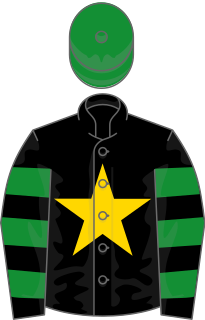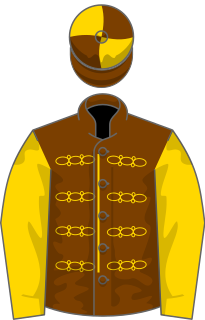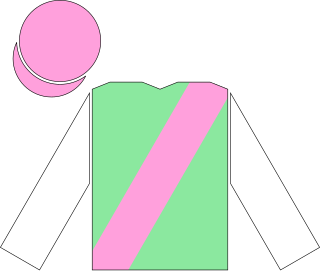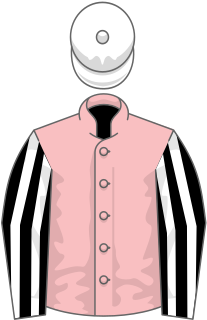
Nijinsky, usually known in the United States as Nijinsky II, was a Canadian-bred, Irish-trained Thoroughbred racehorse and sire. He was the outstanding two-year-old in Europe in 1969 when he was unbeaten in five races. In the following season, he became the first horse for thirty-five years to win the English Triple Crown, a feat that has not been repeated as of 2021. He is regarded by many experts to have been the greatest flat racehorse in Europe during the 20th century.

Santa Claus (1961–1970) was a British-bred, Irish-trained Thoroughbred racehorse and sire. He is most notable for his achievements as a three-year-old in 1964 when he won the Irish 2,000 Guineas, The Derby, and the Irish Derby. His performances earned him the title of British Horse of the Year.

Teenoso was an American-bred British-trained Thoroughbred racehorse. After showing moderate form as a two-year-old he improved in the spring of 1983 to win the Group Three Lingfield Derby Trial and then won the Classic Epsom Derby, giving Lester Piggott a record ninth win in the race. Teenoso was beaten in his two remaining races that year but showed his best form as a four-year-old, winning the Ormonde Stakes, the Grand Prix de Saint-Cloud and, on his final appearance, the King George VI and Queen Elizabeth Stakes. He proved to be a disappointment at stud.

Sir Ivor was an American-bred Irish-trained Thoroughbred racehorse and sire, who competed from a base in Ireland. In a career which lasted from July 1967 to October 1968 he ran thirteen times and won eight races. He won major races in four countries: the National Stakes in Ireland, the Grand Criterium in France, the 2000 Guineas, Epsom Derby and Champion Stakes in England and the Washington, D.C. International in the United States.

Shaamit (1993–2001) was an Irish-bred, British-trained Thoroughbred race horse and sire. In a career which lasted from September 1995 to October 1996, he ran six times and won twice. He was the winner of the Epsom Derby in 1996. He was retired to stud at the end of his three-year-old season where he had limited success. He died in 2001.
Ballymoss (1954–1979) was an Irish Thoroughbred racehorse. In a racing career that lasted from 1956 until November 1958, he ran seventeen times and won eight races. In 1957, he became the first horse trained in Ireland to win the St Leger Stakes. The following season, he was Europe's leading middle-distance horse, winning the King George VI & Queen Elizabeth Stakes and the Prix de l'Arc de Triomphe.
Never Say Die (1951–1975) was an American-bred, British-trained Thoroughbred racehorse. After winning only once from his first nine races, he demonstrated much improved form in the summer of 1954 to win The Derby, becoming the first American colt to win the race in seventy-three years. Later that year he added a second British Classic when winning the St. Leger Stakes by a record margin of twelve lengths. He was later retired to a successful stud career.

Royal Palace (1964–1991) was a British Thoroughbred racehorse. In a racing career which lasted from June 1966 until July 1968 he ran eleven times and won nine races. After being rated the best English-trained two-year-old of 1966, he won the first two legs of the Triple Crown, the 2000 Guineas and the Derby in 1967. He returned for an unbeaten four-year-old season in 1968 when he won four races which are now Group One events.

Camelot is a British-bred, Irish-trained thoroughbred racehorse. He was one of the leading European two-year-olds of 2011 and won the Racing Post Trophy at Doncaster. He was made the winter favourite for the 2000 Guineas and Epsom Derby. On his three-year-old debut, Camelot won the 2000 Guineas at Newmarket and followed up by winning the Derby at Epsom and the Irish Derby at the Curragh. His bid for the Triple Crown failed when he finished runner-up to Encke in the St Leger.
Bruni, was an Irish-bred, British-trained Thoroughbred racehorse. In a career which lasted from 1974 until September 1977, he ran 21 times and won 5 races. He recorded his most important victory when winning the Classic St. Leger Stakes by ten lengths, one of the biggest margins in the race's 200-year history. The following season he became a difficult and temperamental performer, but was one of the leading middle distance horses in Europe, winning two Group races and finishing second in Britain's most prestigious all-aged race, the King George VI and Queen Elizabeth Stakes. He was retired to stud after an unsuccessful five-year-old season.

Toulon (1988–1998), was a Thoroughbred racehorse and sire who was bred in Britain and trained in France. In a career which lasted from October 1990 until October 1992, he ran eleven times and won four races. He recorded his most important success when winning the Classic St. Leger Stakes as a three-year-old in 1990, the same year in which he won the Chester Vase and the Prix Maurice de Nieuil as well as finishing fourth in the Prix de l'Arc de Triomphe. In the following season he failed to win in four races in Europe and had limited success when racing in California in 1993. He was then retired to stud, where he proved to be a successful sire of National Hunt horses.
Snurge, was an Irish-bred British-trained Thoroughbred racehorse and sire. In a career which lasted from September 1989 until September 1994, he ran thirty-four times and won seven races. He recorded his most important success when winning the Classic St. Leger Stakes as a three-year-old maiden in 1990. In the following seasons he won major races in France, Italy and Canada, before retiring as a seven-year-old. At the time of his retirement he held the record for prize money won by a European-trained horse, although the precise total of his earnings was difficult to determine because of the number of different currencies involved.
Boucher, was an American-bred, Irish-trained Thoroughbred racehorse and sire. In Ireland he won the Beresford Stakes as a two-year-old in 1971 and went on to win the Nijinsky Stakes and the Desmond Stakes in 1972. In September 1972 he was sent to England where he won the St. Leger Stakes at Doncaster. At the end of the season he was retired to stand as a stallion in Australia, where he had some success as a sire of winners.
Intermezzo, was a British Thoroughbred racehorse and sire. He won two of his three races as a two-year-old in 1968 and went on to record his most important win in the Classic St. Leger Stakes at Doncaster in September 1969. He raced without winning in 1970 and was exported to stand as stallion in Japan, where he had some success as a sire of winners.
Ribero was an American-bred British-trained Thoroughbred racehorse and sire. In a career which lasted from September 1967 until May 1969 he ran twelve times and won three races. He is best known for his performances in 1968 when he won two of the most important European races for three-year-olds; the Irish Derby, and the St Leger.
Indiana was an Irish-bred, British-trained Thoroughbred racehorse and sire. In a career which lasted from autumn 1963 until July 1965 he ran thirteen times and won four races. He won the Classic St Leger as a three-year-old in 1964, the same year in which he also won the Chester Vase and the Great Voltigeur Stakes. Indiana also finished second in The Derby and the Grand Prix de Paris. He retired from racing and exported in 1966 to stand as a stallion in the Japan. He died in 1983.
Aurelius was an Irish Thoroughbred racehorse and sire best known for winning the classic St Leger Stakes in 1961 and for becoming one of the few classic winners to compete in steeplechases. As a two-year-old he finished fourth in his only appearance but was one of the best colts in Britain in the following year, winning the Craven Stakes and the King Edward VII Stakes before taking the St Leger. He was even better in 1962 when he won the Hardwicke Stakes and was narrowly beaten in the King George VI and Queen Elizabeth Stakes. He was retired to stud but had serious fertility problems and later returned to the racecourse where he had a reasonably successful career in National Hunt racing.
Light Cavalry was a British Thoroughbred racehorse and sire best known for winning the classic St Leger Stakes in 1980. After winning his only race as a two-year-old, Light Cavalry was one of the best three-year-olds in Britain in 1980, winning the King Edward VII Stakes and being placed in the Chester Vase, Gordon Stakes and Great Voltigeur Stakes before winning the St Leger by four lengths. He remained in training in 1981 and won the Princess of Wales's Stakes, but his season was restricted by injury problems. After his retirement from racing he stood as a breeding stallion in the United States and Argentina with limited success.
Connaught was a British Thoroughbred racehorse and sire. Noted for his difficult temperament and front-running style he won seven of his sixteen races in a track career which lasted from October 1967 to July 1970. Owned and bred by Jim Joel, he was trained by Noel Murless and ridden in most of his races by Sandy Barclay.

Quiet Fling was an American-bred, British-trained Thoroughbred racehorse and sire. After finishing second on his only start as a two-year-old he developed into a high-class stayer in the following year when he won two handicap races and finished second in the Irish St. Leger. In 1976 he won the John Porter Stakes and then recorded his biggest win in the Coronation Cup. He failed to win in five subsequent races and was retired to stud at the end of the 1977 season. He had limited success as a breeding stallion.